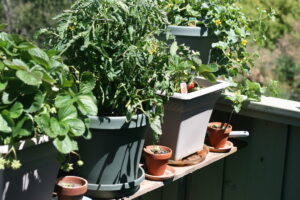
Key Takeaways
-
Biochar is a carbon-rich material that can significantly enhance soil conditions for small fruit production.
-
Understanding your soil’s needs is crucial before incorporating biochar into your orchard.
-
Choosing the right type of biochar and applying it correctly can lead to improved fruit yield and quality.
-
Application techniques and timing are essential to maximize the benefits of biochar.
-
Real-world case studies demonstrate the transformative impact of biochar on small fruit orchards.
What is Biochar and How Can It Revolutionize Your Orchard?
Biochar has been around for centuries. It’s a stable, carbon-rich material created from organic waste through a process called pyrolysis, which involves heating the waste in an environment with little to no oxygen. But only recently has it gained popularity among modern farmers. And for good reason! It improves soil structure, retains nutrients, and helps hold water – all of which are critical for the success of small fruit crops like blueberries, strawberries, raspberries, and grapes. These tiny powerhouses of nutrition require the best possible soil conditions to produce the juicy, flavorful fruits we all love.
Understanding Soil Needs of Small Fruit and the Role of Biochar
Before you go tossing biochar into your soil willy-nilly, you need to understand the specific needs of your small fruit plants. These fruits often prefer slightly acidic to neutral pH soils, well-drained yet moisture-retentive conditions, and a rich supply of organic matter. Biochar can help meet these needs by improving soil fertility and structure.
For example, strawberries are heavy feeders and need rich, fertile soil. By adding biochar, you can ensure that nutrients are available when your strawberries need them. Blueberries, on the other hand, thrive in acidic soil. Biochar can help maintain the pH levels required for these berries to absorb nutrients effectively. Each fruit has its unique requirements, and biochar can be the secret ingredient to meet them all.
Delving into Soil Science: Making the Most of Biochar
Diagnosing Soil Health: When to Consider Biochar
Your soil is like a bank account for your plants, and you want to make sure it’s well-stocked. If you’re noticing that your plants are struggling, your fruit yield is down, or the soil seems lifeless and compacted, it might be time to consider biochar. A soil test is a good starting point to understand what’s missing in your ‘account.’ If the test reveals poor nutrient retention, low organic matter, or a need for pH adjustment, biochar could be your answer.
Types of Biochar: Finding the Right Match for Your Soil
Not all biochar is created equal. The source material and the way it’s processed can affect its properties. For instance, biochar made from hardwood might be best for soils lacking in minerals, while biochar from manure or bone meal could provide more nitrogen – a treat for leafy growth in fruits like strawberries. Here’s a simple guide:
|
Source Material |
Best For |
|---|---|
|
Hardwood |
Mineral-rich biochar for nutrient-deficient soils |
|
Manure |
Nitrogen-rich biochar for leafy growth |
|
Bone Meal |
Phosphorus-rich biochar for root and fruit development |
Choosing the right biochar depends on your soil’s current condition and the specific needs of your small fruit crops. Remember, the goal is to balance your soil ‘account’ to create the perfect growing environment.
Customizing Biochar Application to Soil Type and Condition
Once you’ve got the right type of biochar, you need to tailor its application to your soil’s condition. Sandy soils, for instance, benefit from biochar’s ability to hold water and nutrients that would otherwise wash away. For clay soils, biochar can increase porosity, improving drainage and root penetration. The amount of biochar you’ll use also varies based on your soil test results and the size of your orchard.
Here’s a straightforward approach to customizing biochar application:
-
Conduct a soil test to determine nutrient levels and pH.
-
Choose a biochar that complements your soil’s needs.
-
Apply biochar based on the recommended rate for your soil type – generally, a 5-10% biochar to soil ratio is a good starting point.
-
Monitor your soil and plants’ response over time and adjust the application as needed.
Strategies for Applying Biochar in Various Growth Stages
The timing of biochar application can make a big difference. If you’re starting a new orchard, mixing biochar into the planting holes or rows gives your young plants a head start. For established orchards, you can apply biochar as a top dressing or work it into the soil during dormant seasons to minimize disturbance to the roots.
Let’s break it down by growth stage:
-
Planting: Mix biochar with soil at the bottom of each planting hole.
-
Young Orchards: Apply biochar as a top dressing around the base of the plants.
-
Mature Orchards: Incorporate biochar into the soil during dormant periods.
Remember, biochar is not a one-time fix; it’s a long-term investment in your soil’s health. Therefore, periodic applications may be necessary to maintain the benefits.
The Biochar Buying Guide for Fruit Producers
Key Characteristics to Look for in High-Quality Biochar
When you’re in the market for biochar, it’s like picking out the best seeds for planting; you want the highest quality to ensure the best growth. High-quality biochar should have a high carbon content, a porous structure, and a large surface area. These characteristics ensure that it can effectively retain water and nutrients, and provide a habitat for beneficial soil microbes. The biochar should also be free from contaminants, which could harm your plants. So, make sure to ask for a detailed analysis of the biochar you’re considering.
Local Sources vs. Commercial Products: Weighing Your Options
Now, where do you get this biochar? You’ve got two main options: local sources or commercial products. Local sources can be more cost-effective and reduce your carbon footprint, as the biochar hasn’t traveled far. However, the quality can vary, so it’s crucial to verify the production process and material used. Commercial products, while potentially more expensive, often come with quality assurances and consistent characteristics. Weigh these options against your orchard’s needs and your budget.
Maximizing Benefits: Proper Biochar Use in Your Orchards
Application Techniques: Getting Biochar into the Soil
Applying biochar is not a ‘sprinkle and hope for the best’ situation. To get it into the soil, you have several techniques at your disposal. You can till it in, which is great for preparing new beds, or you can use a no-till method, layering the biochar on top and allowing natural processes to incorporate it. You could also combine biochar with compost, which enriches it with microbes before it even touches your soil. Each method has its merits, so choose based on your orchard’s condition and your farming philosophy.
Timing and Dosage: Ensuring Optimal Impact on Fruit Quality
Timing and dosage of biochar application are crucial. It’s like feeding your plants; too little, and they won’t thrive; too much, and you could overwhelm them. The best time to apply biochar is before planting or at the beginning of the growing season. This gives the biochar time to integrate with the soil and start improving its quality. As for dosage, a general rule of thumb is to apply about 1 to 2 inches of biochar over the intended area and work it into the top 6 to 8 inches of soil. But always refer back to your soil test results to tailor the dosage to your specific needs.
-
Apply 1 to 2 inches of biochar to the soil surface.
-
Incorporate it into the top 6 to 8 inches of soil.
-
Adjust dosage based on soil test results and crop needs.
Maintaining Orchard Health Post-Application
After you’ve applied biochar, it’s not time to sit back and relax just yet. You need to maintain your orchard health to ensure that the biochar continues to do its job. This means regular monitoring of soil pH, moisture levels, and nutrient status. It also means being mindful of your orchard practices, such as irrigation and pest management, to support the biochar-enhanced environment you’ve created.
From Science to Practice: Real-World Success with Biochar
Let’s talk about real-world success. There’s a blueberry farm that started using biochar and saw its berry size increase and the flavor profile improve. They applied biochar before planting new bushes and worked it into the soil around established plants. The results were so impressive that neighboring farms started to take notice. This is just one example of how biochar can transform small fruit production.
-
Increased berry size and improved flavor profile in blueberries.
-
Application of biochar before planting and around established plants led to noticeable improvements.
In the heart of Oregon, a raspberry farm was struggling with acidic soils and low yields. After incorporating biochar into their soil management practices, they witnessed a remarkable turnaround. The biochar helped to neutralize the soil pH and increase nutrient availability, leading to a significant boost in berry size and yield.
This success story is echoed by numerous other small fruit producers who have seen similar results, highlighting biochar’s potential to revitalize underperforming orchards.
Remember, biochar can be a game-changer for your soil and your crops. But like any tool, its success depends on how you use it. Understand your soil, choose the right biochar, apply it correctly, and maintain your orchard with care. Do this, and you’re well on your way to reaping the sweet rewards of your labor.
FAQ
How Does Biochar Improve Soil Fertility Over Time?
Biochar works like a sponge in the soil, holding onto nutrients and water that plants can access when they need them. Over time, this leads to a buildup of soil organic matter and a thriving community of beneficial microbes. These microbes break down organic material into plant-available nutrients, further enhancing soil fertility. The porous nature of biochar also improves aeration, which is essential for healthy root development.
Additionally, biochar is incredibly stable and can remain in the soil for hundreds of years, continually contributing to soil fertility. Its long-lasting presence means that the benefits of a single application can be reaped for multiple growing seasons.
-
Retains nutrients and water in the soil
-
Builds soil organic matter
-
Supports beneficial soil microbes
-
Improves soil aeration
-
Provides long-lasting fertility benefits
Can Biochar be Used for All Types of Small Fruit Crops?
Absolutely, biochar is versatile and beneficial for a wide range of small fruit crops, including blueberries, strawberries, raspberries, and grapes. Each of these crops has unique soil requirements, and biochar can be customized to suit their specific needs. Whether it’s adjusting soil pH for blueberries or boosting nutrient retention for strawberries, biochar can be tailored to enhance the growing conditions for any small fruit crop.
How Often Should Biochar be Reapplied to the Soil?
Because of its stability, biochar doesn’t need to be reapplied as frequently as other soil amendments. Generally, a significant application can last several years before additional biochar might be beneficial. However, ongoing soil testing is recommended to determine if and when more biochar should be added. As your orchard grows and soil conditions change, these tests can guide you in maintaining optimal soil health.
Is There Any Small Fruit Variety That Doesn’t Respond Well to Biochar?
While biochar has broad benefits for small fruit production, there may be specific varieties or conditions where its impact is less pronounced. For instance, fruits that thrive in highly alkaline soils may not see as much benefit if the biochar used lowers the pH. It’s always important to match the type of biochar to the specific soil and crop requirements. If in doubt, start with a small test plot to gauge the effects before applying biochar more broadly.
What Are the Environmental Impacts of Using Biochar?
Biochar is considered a win-win for agriculture and the environment. It not only boosts crop yields but also helps combat climate change by sequestering carbon in the soil. This carbon would otherwise be released into the atmosphere as greenhouse gases. Moreover, by improving soil health, biochar can reduce the need for chemical fertilizers, leading to less runoff and pollution of waterways. Its use in agriculture is a sustainable practice that benefits the planet while enhancing crop production.



